Long and Short Chapter Notes | Mathematics for Class 4: NCERT PDF Download
Introduction
"Long and short" are words we use to talk about how big or small something is. When we say something is "long," it means it's really big. And when we say something is "short," it's not as big. We use these words to measure things like distance, time, or height.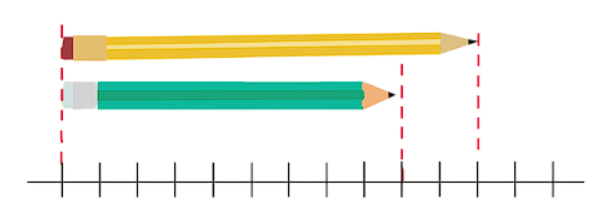
In the image provided, there are two pencils of different lengths.
- The yellow pencil measures 11 units, while the green pencil measures 9 units.
- Since 9 is less than 11, we can conclude that the yellow pencil is longer, and the green pencil is shorter.
How Far Apart are the Dots?
Imagine you have two dots on a piece of paper. The distance between these two dots is how far apart they are from each other. We can measure this distance using a ruler, and the measurement is usually in centimeters (cm). Understanding how to measure distances helps us know exactly how far one thing is from another.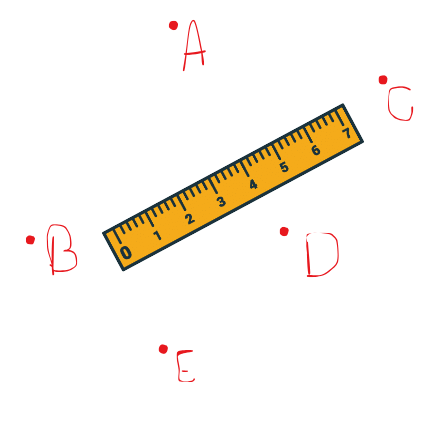
For example, if you guessed that the dots are 5 cm apart and then measured them with a ruler, you might find out if your guess was correct. Sometimes things might look closer or farther away than they really are, and measuring helps us find out the exact distance.
The Shorter Line
Let’s say there are two lines on a piece of paper. One line is longer, and the other is shorter. You can see that one is longer just by looking at them. But what if you want to make the longer line look shorter without erasing it? You could draw an even longer line next to it! This makes the first line seem shorter by comparison.
This teaches us that sometimes things can look different depending on what they’re next to. It’s all about comparing one thing with another.
How Tall Have You Grown?
- As you grow older, you get taller. Every year, you can measure your height to see how much you’ve grown.
- For example, if last year you were 120 cm tall and this year you are 130 cm tall, you have grown by 10 cm.
- It’s not just you—everyone in your family grows too.
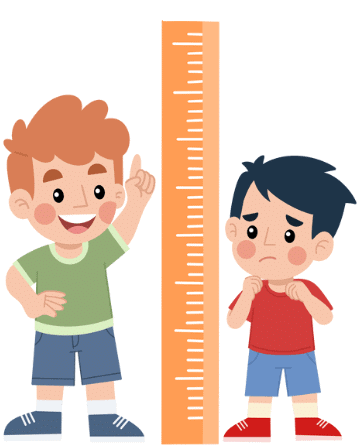
- By measuring your height and comparing it with your family members, you can see who is the tallest and who is the shortest.
- This helps you understand how people grow at different rates.
Length and Distance
Distance refers to the measurement of the length between objects, like the length of a road indicating how far it stretches. It essentially represents the separation or space between objects, whether it's the distance between two cities or between two specific points.
The Long and Short of Your Family!
Let’s think about the heights of people in your family. If someone is twice as tall as you, it means if you stack yourself on top of yourself, you’d reach their height. Comparing the heights of your family members helps you understand how tall or short someone is compared to others.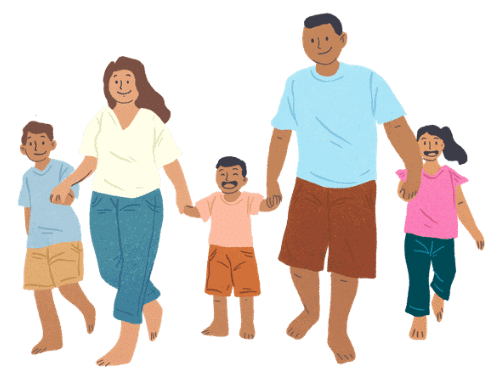
For example, if your dad is 180 cm tall and you are 90 cm tall, your dad is exactly twice as tall as you. This shows how we can use measurements to compare sizes.
How Many Rooms High?
- When we talk about tall buildings or towers, we sometimes compare them to something we know, like the height of a room.
- If a building is really tall, we might say it’s as tall as 24 rooms stacked on top of each other.

- For example, the Qutab Minar is 72 meters tall. If each room in your house is 3 meters tall, you would need 24 rooms stacked up to reach the height of the Qutab Minar. This helps us imagine how tall something really is by comparing it to something familiar.
Units of Length and Distance
There are several units of distance and the most commonly used ones are Millimetres, centimetres, metres, Kilometres etc.
(a) Millimetres: Millimetres is a unit of length in the metric system. A millimetre is one-thousandth of a metre. It is represented by ‘mm’.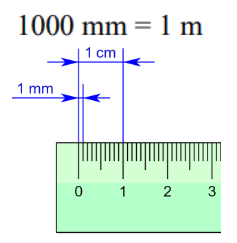
(b) Centimeters: Centimetres are a unit of length in the metric system, equal to one-hundredth of a meter. It is denoted by ‘cm
100 cm = 1m
(c) Meters: Meters are the basic units of measurement in the metric system, represented by 'm'.
(d) Kilometers: Kilometers are units of length in the metric system, equivalent to one thousand meters. They are denoted by 'km'.
Solved Examples
Example 1: Look for things in your surroundings that are
(i) About 10 centimeters long
(ii) Between 10 and 20 centimeters long
(iii) Less than 1 cm long.
(i) The things that are about 10 cm long are:
Tea Mug, Cell phones, Hair comb, etc
(ii) The things that are about 10 cm and 20 cm long are:
Soft Drinks bottles, Dinner forks, Carrots etc.
(iii) The things that are less than 1 cm long are:
Watermelon seed, a single piece of rice, a piece of daal, etc.
Example 2: Convert the following into meters
(i) 700 cm
(ii) 3000 mm
(iii) 2 km
To convert the following into metres we need to scale between the following and meters.
(i) 700 cm
We know that 100 cm = 1 m, therefore 700 cm can be obtained by multiplying 7 on both sides. i.e
= 7(100 ) 7(1 ) cm m = 700 7 . cm m
(ii) 3000 mm
We know that 1000 mm = 1 m, therefore 3000 mm can be obtained by multiplying 3 on both sides. i.e
= 3(1000 ) 3(1 ) mm m = 3000 3 . mm m
(iii) 2 km
We know that 1000 m = 1 km, therefore 2000 m can be obtained by multiplying 2 on both sides. i.e
= 2(1000 ) 2(1 )
= 2km = 2000m
(i) 5 meters
(ii) 800 mm
(iii) 3.5 km
(iv) 2500 cm
Quick Revision: Units of Measurement of Length
|
26 videos|142 docs|34 tests
|
FAQs on Long and Short Chapter Notes - Mathematics for Class 4: NCERT
| 1. How can we determine the distance between two points on a line segment? |  |
| 2. How can we measure the height of an object using another object of known length? |  |
| 3. How can we compare the heights of different family members using a common unit of measurement? |  |
| 4. How can we calculate the total height of a building based on the number of floors it has? |  |
| 5. What are some common units of length and distance used for measurement? |  |
















